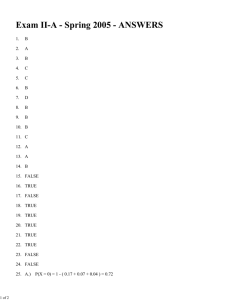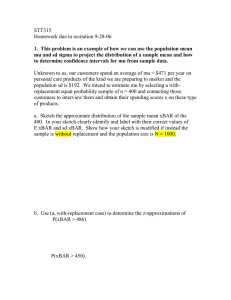Recitation assignment 2-16-06. ... This material is a bridge between probability and
advertisement
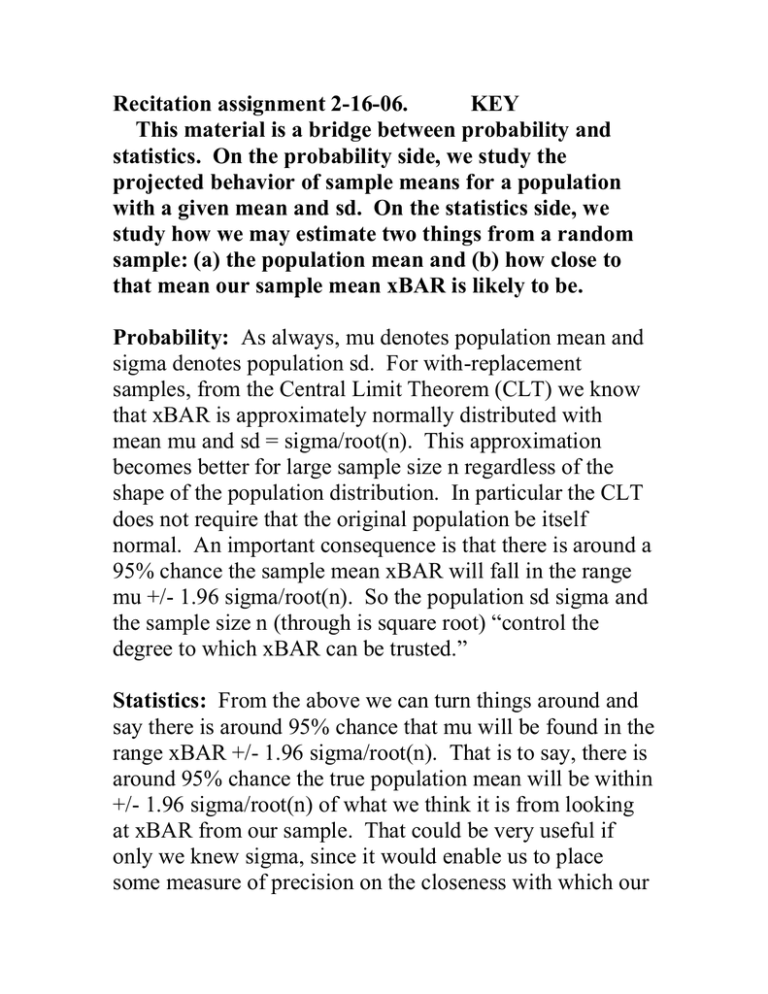
Recitation assignment 2-16-06. KEY This material is a bridge between probability and statistics. On the probability side, we study the projected behavior of sample means for a population with a given mean and sd. On the statistics side, we study how we may estimate two things from a random sample: (a) the population mean and (b) how close to that mean our sample mean xBAR is likely to be. Probability: As always, mu denotes population mean and sigma denotes population sd. For with-replacement samples, from the Central Limit Theorem (CLT) we know that xBAR is approximately normally distributed with mean mu and sd = sigma/root(n). This approximation becomes better for large sample size n regardless of the shape of the population distribution. In particular the CLT does not require that the original population be itself normal. An important consequence is that there is around a 95% chance the sample mean xBAR will fall in the range mu +/- 1.96 sigma/root(n). So the population sd sigma and the sample size n (through is square root) “control the degree to which xBAR can be trusted.” Statistics: From the above we can turn things around and say there is around 95% chance that mu will be found in the range xBAR +/- 1.96 sigma/root(n). That is to say, there is around 95% chance the true population mean will be within +/- 1.96 sigma/root(n) of what we think it is from looking at xBAR from our sample. That could be very useful if only we knew sigma, since it would enable us to place some measure of precision on the closeness with which our sample mean xBAR has likely estimated the true population mean mu. Probability: “No problem mate.” Since the sample sd s tends to sigma as n grows large it can also be proven that there is also around 95% chance that mu is within the range xBAR +/- 1.96 s/root(n). This is a tweak of the CLT. Note: ME = 1.96 s/root(n) (although 1.96 sigma/root(n) is also sometimes used, but we will not do so). Note also: SE (standard error) of xBAR is defined to be s/root(n) (without the 1.96). It is our estimate of the sd of xBAR. That is, our estimate of the sd of our estimate. Always show your method! 1. The profit from each sale made by a company is regarded as a random sample made with-replacement from a distribution having mean $47.51 and sd 31.22. a. The above reflects wide sampling variation, why? ans. Because 31.22 is large relative to the mean 47.51. In fact, if the population were itself normal there would be around 32% of sales differing from 47.51 by more than 31.22 in either direction. b. If a sample of 50 sales is selected with-replacement what are the expected value and sd of the profit from the first sale (sample of one)? ans. A single random sample has the full range of possibilites as the population itself. So the expectation is again 47.51 and the sd is 31.22. c. Refer to (b). What are the expected value and sd of the total profit from 50 such sales? ans. E total = total of expectations = 50 (47.51). Var total = total of variances = 50 31.222 (req indep) sd total = root of Var total = root(50) (31.22). d. Refer to (c). Sketch the approximate normal distribution of total profit suggested by the CLT. ans. Bell curve with mean 50 (47.51) and sd root(50) (31.22). Note that the sd of total is a relatively small part of the expected total, which was not the case for individual scores in this population. e. Refer to (b). What are the expected value and sd of the sample average profit from 50 such sales? ans. E xBAR = mu = 47.51. sd xBAR = sigma/root(n) = 31.22 / root(50). Note that for n = 1 we get our answer to part (a) since a single sample score is interpretable a the average xBAR from a sample of n equal to one. f. Refer to (e). Sketch the approximate normal distribution of sample average profit. ans. Bell curve having mean 47.51 and sd 31.22 / root(50). Label the horizontal axis xBAR. 2. A company has 10,678 employees whose projected benefit scores x can only be determined by careful health audit. From them, an equal probability withoutreplacement sample of 70 will be selected for this audit. Suppose (unknown to the company) the scores x have a population average of $634 with sd $244. a. Do we know that the population distribution of health score x is normal? Sketch what the population distribution would look like if it were normal. ans. We do not know the shape of the population distribution. All we know are the mean and sd of that distribution. We can sketch a bell curve having mean 634 and sd 244 to see what the population distribution would look like for the normal case. There may be good reasons for a non-normal distribution. For example, younger workers may have fewer health care costs (except for pregnancy and some types of injury) than older ones. This would lead to a distribution with many peaks. While the mean of such a non-normal distribution is recognized as the balance point there is no easy way to discern the sd. b. If a sample of 70 employees is selected withoutreplacement what are the expected value and sd of the health score X from the first person sampled (sample of one). ans. 634 and 244, same as for 1b. c. Refer to (b). What are the expected value and sd of the sample average health score from 70 employees. ans. E xBAR = mu = 634. sd xBAR = (sigma / root(n)) FPC where the finite population correction (FPC) is figured FPC = root( (N-n) / (N-1)) = root((10678-70) / (10678-1)) = .996764 ~ 1. so the sd of xBAR for a WITHOUT repl sample of 70 is (244 / root(70)) root((10678-70) / (10678-1)) = 29.07. This is exactly true (except for rounding). We’ve not proven it as we did for the with-replacement case, but the proof is just another application of the rules for expectation and variance. It makes use of the simple arithmetic observation that the mean of a population with “me” removed is (mu N – my score) / (N-1). This is where the N-1 in the FPC comes from. d. Refer to (c). Sketch the approximate distribution of the sample average health score from 70 sample employees. ans. Bell curve with mean 634 and sd 29.07 from (c). e. If we do select a random with-replacement sample of 70 employees and calculate their sample mean, around what value do we expect to get? Around what value would we get for the sample sd? Remember, the sample is likely to resemble the population in respect of one or a few characteristics (or more if there is a lot of data) chosen in advance of looking at the data. ans. xBAR is hunting for mu and s is hunting for sigma. The sample quantities are hunting for their population counterparts. A sample is likely to resemble the population. We look to get a sample mean xBAR of around 634 and a sample sd of around 244. Note: It is NOT true that E s = sigma, but the difference can be proven to be of smaller order (1/n) than is the sample variation (1/root(n)). So the BIAS = E s – sigma is generally ignored as a minor player. f. Determine the approximate probability that the sample mean health score will under-estimate the population mean by more than $50. Use the z-method. ans. P(xBAR < mu – 50) is sought. P(xBAR < 634 – 50) = P( xBAR < 584) ~ P( Z < (584-mu) /sd of xBAR)) = P( Z < (584-634) / 29.069) = P( Z < -50 / 29.069) = P( Z < - 1.72) z .02 1.7 .4573 = .5 - .4573 = 0.0427. 3. Refer to (1b). Suppose that the random WITHreplacement sample of 50 yields a sample mean of 52.4 and a sample sd s of 28.6. a. Determine the margin of error for the sample mean (using s, as we have done, and not the population sd). ans. +/- ME = 1.96 s/root(n) = +/- 1.96 28.6 / root(50) = +/- 7.92752 b. Determine a 95% confidence interval for the population mean from this sample. Such an interval is random (depends totally on the sample) and has around a 95% chance of enclosing the population mean. Does it enclose mu in this case? ans. The 95% CI recipe is: xBAR +/- 1.96 s / root(n) = 54.2 +/- 7.92752 = [46.2725, 62.1275] which DOES enclose mu = 47.51 from problem 1. Around 95% of samples of 50 have this happen; around 5% do not. c. Determine a 92% confidence interval for the population mean. You will need to consult the z-table. ans. We require the z-score for 92%. Enter .92/2 = .46 to the body of the z-table and read off z. xBAR +/- z s/root(n) z .05 54.2 +/- 1.75 28.6 / root(50) 1.7 .4599 (closest) 4. Suppose that a population of account balances has been brought under statistical control with mean $73.22 and s.d. $5.74. AHAH! THE ASSUMPTION NEEDED FOR t. a. Sketch the form of the population distribution. ans. Bell curve having mean 73.22 and sd 5.74. b. Sketch the form of the distribution of the sample mean of a random with-replacement sample of 100 accounts. Do so in the same scale as used for (a) above in order that the two may be compared. What is the comparison in respect of the means and sd’s? ans. E xBAR = 73.22. sd xBAR = sigma/root(n) = 5.74/root(100) = 0.574. Bell curve having mean 73.22 and sd 0.574. This is not an approximation afforded by the CLT. Rather, it is exactly the distribution of xBAR since the population is itself normal. xBAR has sd only one tenth that of pop. c. A sample of n = 5 accounts is selected withreplacement. Suppose that the sample mean is $70.52 with sample sd s = $6.57. Give a t-based 95% confidence interval for the population mean based upon this sample. ans. xBAR +/- t s / root(n) 70.52 +/- 2.776 6.57 / root(5) [62.3636, 78.6764] t DF 5-1=4 2.776 inf 1.96 CI 95% d. Refer to (c) above. There is 95% chance that such a confidence interval will contain the true population mean. Has this one done so? ans. Yes, the true population mean 73.22 has been enclosed by the 95% CI obtained from this particular sample of 5. Around 95% of such CI will enclose the truth; around 5% will not. Statistics defines the tradeoff between width of CI and desired probability of covering the unknown population mean with the CI. e. Why would it have been wrong to use 1.96 to form this interval? What did we assume, not assumed in (1), that makes the t-method applicable to this problem? ans. We assumed NORMAL population, which was not assumed in 1. When fabricating this CI, had we employed the population sd sigma = 5.74 instead of the sample sd s = 6.57 we would have been entitled to use the z-score 1.96 rather than the t-score 2.776. The reason for 2.776 is larger than 1.96 is that, by using s to estimate sigma, our CI has to contend with the additional uncertainty introduced thus must widen the CI accordingly. Usually, sigma is not known, so the tinterval must be used. We do (sometimes) wish to check up on the mean of a process that historically has had a given sd (perhaps we’ve known the mean to be 73.22 and the sd to be 5.74 in the past). In such a case we may decide to use this sigma 5.74 and employ the z-score (rather than use s and the larger t-score). That may not be such a good idea however, since a change in the mean of the process could well be associated with a change in the sd as well. 5. An advertiser wishes to estimate the proportion p of consumers who will favor a new package over the existing one. A with-replacement sample of 40 consumers will be panel-tested to determine their preferences. a. Suppose (unknown to the company) that 32% of consumers favor the new package. Sketch the approximate distribution of the sample fraction pHAT who will favor the new package. ans. Bell curve with mean .32 and sd root(.32 .68) / root(40). Note that root(.32 .68) is the population sd for the score x = 1 (favor) and x = 0 (not favor). This is a special case of the distribution of xBAR since, for 0-1 scoring, xBAR is just the sample proportion pHAT. b. Suppose that of the 40 sample consumers there are 17 who favor the new package. What are your estimates of p and the sd of the population? ans. pHAT = 17 / 40 = 0.425 is our estimate of p = 0.32. root(pHAT qHAT) = root(.425 .575) = 0.494343 is our estimate of sigma = root(.32 .68) = 0.466476. Note that in general root(p q) ~ 0.5 when p is even near to 0.5. Why not (for 0-1 scores) use the estimate s/root(n)? It is traditional to dispense with s in this case. By using root(pHAT qHAT) we are, if effect, replacing the unusual (n-1) divisor under the radical in s with divisor n, just as when computing any regular sd. c. Refer to (b). Give the standard error AND MARGIN OF ERROR of pHAT for this sample. ans. SE = root(pHAT qHAT) / root(n) = root(.425 .575) / root(40) = 0.0781625 is our estimate for sd of pHAT. ME = +/- 1.96 SE = +/- 1.96 root(pHAT qHAT) / root(n) = +/- 1.96 (0.0781625) d. Refer to (a, b). Give a 97% confidence interval for p based upon the CLT. Around 97% of the time such an interval should cover p. Does it in this case? ans. We require z-score for .97 / 2 = 0.485. z .07 2.1 0.485 read off z = 2.17 pHAT +/- 2.17 SE 0.425 +/- 2.17 root(.425 .575) / root(40) [0.255387, 0.594613] This CI does cover the true population p = 0.32. Around 97% of samples of 40 would produce a 97% CI covering p. Around 3% of same would not cover p.
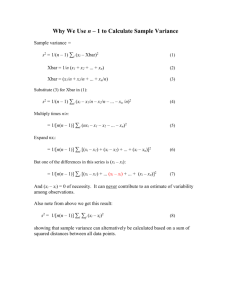
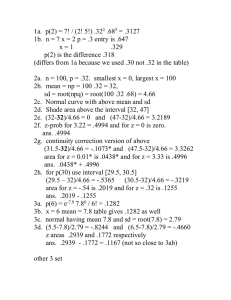
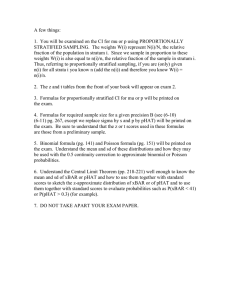
![STT 315 Fall 06 EXAM 2 KEY ... 1. Use z-table to evaluate P(Z in [-1.44, 1.67]).](http://s2.studylib.net/store/data/011876828_1-4b26acc4998e0bd694d982aaf88a02b1-300x300.png)
